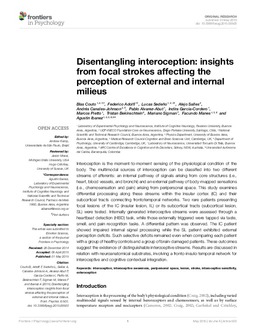| dc.rights.license | https://creativecommons.org/licenses/by/4.0/ | es_AR |
| dc.contributor.author | Couto, Blas | es_AR |
| dc.date.accessioned | 2018-08-05T19:26:00Z | |
| dc.date.available | 2018-08-05T19:26:00Z | |
| dc.date.issued | 2015-05-01 | |
| dc.identifier | doi: 10.3389/fpsyg.2015.00503 | es_AR |
| dc.identifier.uri | https://doi.org/10.3389/fpsyg.2015.00503 | es_AR |
| dc.identifier.uri | https://repositorio.utdt.edu/handle/20.500.13098/11074 | |
| dc.description.abstract | Interoception is the moment-to-moment sensing of the physiological condition of the body. The multimodal sources of interoception can be classified into two different streams of afferents: an internal pathway of signals arising from core structures (i.e., heart, blood vessels, and bronchi) and an external pathway of body-mapped sensations (i.e., chemosensation and pain) arising from peripersonal space. This study examines differential processing along these streams within the insular cortex (IC) and their subcortical tracts connecting frontotemporal networks. Two rare patients presenting focal lesions of the IC (insular lesion, IL) or its subcortical tracts (subcortical lesion, SL) were tested. Internally generated interoceptive streams were assessed through a heartbeat detection (HBD) task, while those externally triggered were tapped via taste, smell, and pain recognition tasks. A differential pattern was observed. The IC patient showed impaired internal signal processing while the SL patient exhibited external perception deficits. Such selective deficits remained even when comparing each patient with a group of healthy controls and a group of brain-damaged patients. These outcomes suggest the existence of distinguishable interoceptive streams. Results are discussed in relation with neuroanatomical substrates, involving a fronto-insulo-temporal network for interoceptive and cognitive contextual integration. | es_AR |
| dc.format.extent | 17 p. | es_AR |
| dc.format.medium | application/pdf | es_AR |
| dc.language | eng | es_AR |
| dc.relation.ispartof | Frontiers in Psychology. 6:503, (may. 2015). ISSN: 1664-042X | es_AR |
| dc.rights | info:eu-repo/semantics/openAccess | es_AR |
| dc.subject | Lesión | es_AR |
| dc.subject | Neuropsicología | es_AR |
| dc.subject | Sensibilización ambiental | es_AR |
| dc.subject | Percepción de distancia | es_AR |
| dc.title | Disentangling interoception : insights from focal strokes affecting the perception of external and internal milieus | es_AR |
| dc.type | info:eu-repo/semantics/article | es_AR |
| dc.subject.keyword | Interoception | es_AR |
| dc.subject.keyword | Interoceptive awareness | es_AR |
| dc.subject.keyword | Peripersonal space | es_AR |
| dc.subject.keyword | Lesion | es_AR |
| dc.subject.keyword | Stroke | es_AR |
| dc.subject.keyword | Interoceptive sensitivity | es_AR |
| dc.subject.keyword | Exteroception | es_AR |
| dc.type.version | info:eu-repo/semantics/publishedVersion | es_AR |
| dc.description.filiation | Fil: Couto, Blas. Laboratory of Experimental Psychology and Neuroscience, Institute of Cognitive Neurology, Favaloro University, Buenos Aires, Argentina. UDP-INECO Foundation Core on Neuroscience, Diego Portales University, Santiago, Chile. National Scientific and Technical Research Council, Buenos Aires, Argentina | es_AR |

